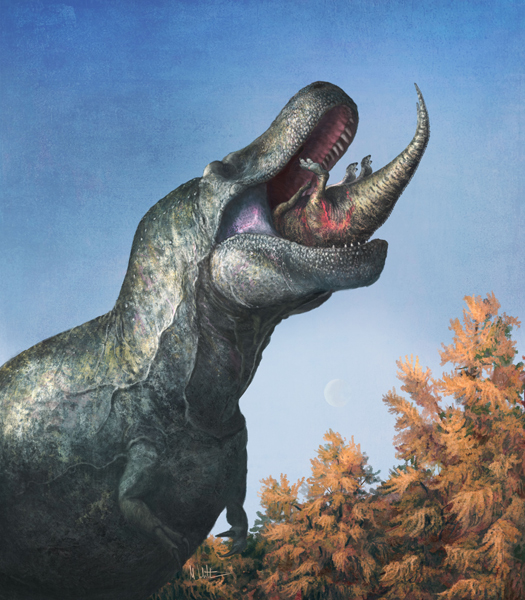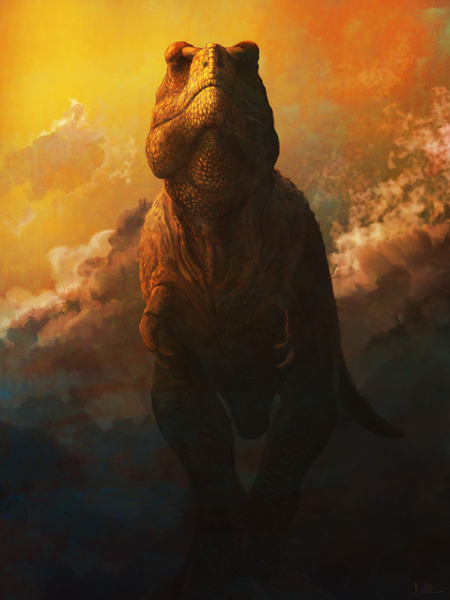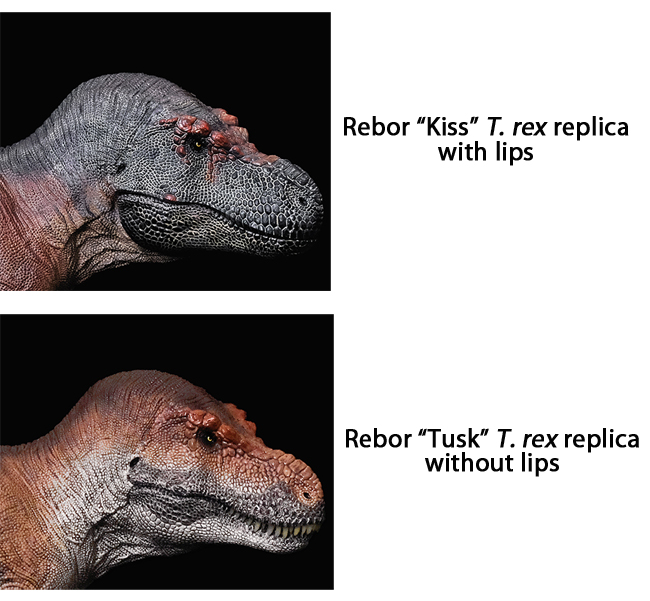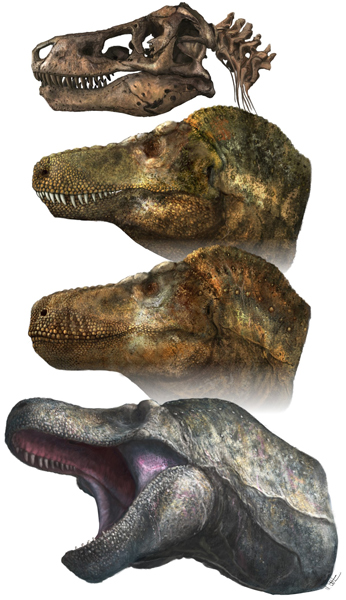New Study Suggests Tyrannosaurus rex Had Lips
Large, predatory theropod dinosaurs are often portrayed as fierce-looking monsters, with huge and highly visible teeth. These teeth are visible over the jaw line when the meat-eating dinosaur’s mouth is closed. This is reminiscent of the appearance of modern crocodilians, which after all, are closely related to fellow archosaurs such as the theropod members of the Dinosauria. However, a new study suggests predatory dinosaurs had scaly, lizard-like lips. Even Tyrannosaurus rex had lips according to a new paper published in the academic journal Science.

Tyrannosaurus rex Had Lips
The researchers including Dr Mark Witton (University of Portsmouth) and the study lead author Assistant Professor Thomas M. Cullen (Auburn University, Alabama) suggest that carnivores such as Tyrannosaurus rex did not have permanently exposed teeth. Films such as “Jurassic Park”, many palaeoartists and numerous model manufacturers have got it wrong. Instead, these dinosaurs had scaly lips, covering and sealing their mouths.
The debate as to whether theropod dinosaurs such as Giganotosaurus, Velociraptor, T. rex and Allosaurus had lips has gone on for some time. Did these dinosaurs have perpetually visible upper teeth that hung over their lower jaws and were therefore exposed and on view even with the jaw closed? The researchers suggest that dinosaurs such as Tyrannosaurus rex did not have a smile like a crocodile. Theropods possessed lips similar to those of lizards and the ancient reptile Tuatara, the only extant member of the Rhynchocephalia.
Detailed Study
In the most detailed study concerning the presence or otherwise of extraoral tissue in the Theropoda conducted to date, the researchers examined the tooth structure, wear patterns and jaw morphology of lipped and lipless reptile groups and found that theropod mouth anatomy and functionality resembles that of lizards more than the mouths of crocodilians.
These lips were probably not muscular, like those of mammals. Most reptile lips cover their teeth but cannot be moved independently, a reptile can’t curl its lips back and snarl like a dog. They could not make the sort of movements that we might associate with our faces or that of other mammals.
Derek Larson, Collections Manager and Researcher in Palaeontology at the Royal BC Museum in Canada and a co-author of the study stated:
“Palaeontologists often like to compare extinct animals to their closest living relatives, but in the case of dinosaurs, their closest relatives have been evolutionarily distinct for hundreds of millions of years and today are incredibly specialised.”
The research team concluded that theropod teeth were extremely similar to the teeth of monitor lizards (varanids). The teeth are thought to have functioned in the same way, so perhaps monitor lizards such as the Komodo dragon (Varanus komodoensis) can be favourably compared to extinct animals such as theropod dinosaurs, even though the Varanidae as members of the Squamata, are only very distantly related to the Dinosauria.
Upending Popular Theropod Depictions
Co-author Dr Mark Witton (University of Portsmouth) explained:
“Dinosaur artists have gone back and forth on lips since we started restoring dinosaurs during the 19th century, but lipless dinosaurs became more prominent in the 1980s and 1990s. They were then deeply rooted in popular culture through films and documentaries — Jurassic Park and its sequels, Walking with Dinosaurs and so on. Curiously, there was never a dedicated study or discovery instigating this change and, to a large extent, it probably reflected preference for a new, ferocious-looking aesthetic rather than a shift in scientific thinking. We’re upending this popular depiction by covering their teeth with lizard-like lips. This means a lot of our favourite dinosaur depictions are incorrect, including the iconic Jurassic Park T. rex.”
The Implications of “Tyrannosaurus rex Had Lips”
The results of the study, found that tooth wear in lipless animals was markedly different from that seen in carnivorous dinosaurs and that dinosaur teeth were no larger, relative to skull size, than those of modern lizards, implying they were not too big to cover with lips.
Furthermore, the distribution of small holes around the jaws, which supply nerves and blood to the gums and tissues around the mouth, were more lizard-like in dinosaurs than crocodile-like. In addition, modelling mouth closure of lipless theropod jaws showed that the lower jaw either had to crush jaw-supporting bones or disarticulate the jaw joint to seal the mouth.

Kirstin Brink (Assistant Professor of Palaeontology at the University of Manitoba, Canada) and fellow co-author of the scientific paper commented:
“As any dentist will tell you, saliva is important for maintaining the health of your teeth. Teeth that are not covered by lips risk drying out and can be subject to more damage during feeding or fighting, as we see in crocodiles, but not in dinosaurs.”
Assistant Professor Brink added:
“Dinosaur teeth have very thin enamel and mammal teeth have thick enamel (with some exceptions). Crocodile enamel is a bit thicker than dinosaur enamel, but not as thick as mammalian enamel. There are some mammal groups that do have exposed enamel, but their enamel is modified to withstand exposure.”
Theropod Teeth are Not Oversized
Previously, it had been suggested that the teeth of predatory dinosaurs were just too big to be covered by lips. This study challenges that view and suggests that theropod teeth were not atypically large. Even the huge, banana-shaped teeth of tyrannosaurs are proportionally similar in size to living predatory lizards when the actual skull size is considered. Therefore, the researchers reject the hypothesis that theropod teeth were too large to be covered by lips.
Model makers and figure manufacturers have created figures that reflect the current scientific debate about the presence or otherwise of lips in theropod dinosaurs. For example, Rebor recently introduced two new Tyrannosaurus rex figures “Kiss” being a lipped model, whereas the counterpart figure “Tusk” was lipless.

To view the range of Rebor figures and replicas in stock at Everything Dinosaur: Rebor Models and Figures.
Important Implications with Regards to Reconstructing Theropod Dinosaurs
This new study provides a new perspective on the “lips” versus “lipless” debate. It provides new insights into how scientists, artists and model makers reconstruct the soft tissues of dinosaurs and other prehistoric animals. This research provides information on how theropod dinosaurs fed, how they maintained their dental health as well as broader issues such as dinosaur ecology and evolution.
Dr Witton summarised the study stating:
“Some take the view that we’re clueless about the appearance of dinosaurs beyond basic features like the number of fingers and toes. But our study, and others like it, show that we have an increasingly good handle on many aspects of dinosaur appearance. Far from being clueless, we’re now at a point where we can say ‘oh, that doesn’t have lips? Or a certain type of scale or feather?’ Then that’s as realistic a depiction of that species as a tiger without stripes.”
The research team stress that their study does not say that no extinct animals had exposed teeth — some, like sabre-toothed carnivorous mammals, or marine reptiles and flying reptiles with extremely long, interlocking teeth, almost certainly did.
Everything Dinosaur acknowledges the assistance of a media release in the compilation of this article.
The scientific paper: “Theropod dinosaur facial reconstruction and the importance of soft tissues in paleobiology” by Thomas M. Cullen, Derek W. Larson, Mark P. Witton, Diane Scott, Tea Maho, Kirstin S. Brink, David C. Evans and Robert Reisz published in the journal Science.


